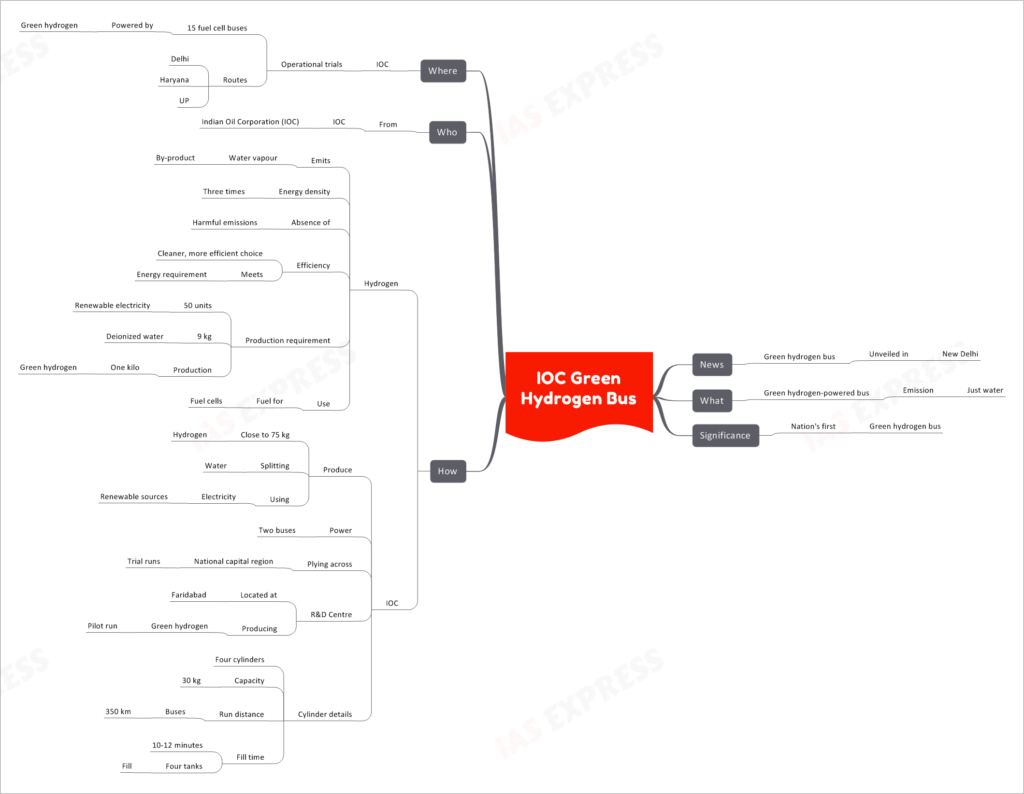IOC Green Hydrogen Bus

In a significant step towards a sustainable future, Indian Oil Corporation (IOC) has unveiled the nation’s first green hydrogen-powered bus in New Delhi. This groundbreaking development represents a major leap in the adoption of clean energy solutions and underscores the importance of green hydrogen as an environmentally friendly fuel source.
The Green Hydrogen Bus: A Clean Mobility Solution
What is it? The green hydrogen bus is a remarkable innovation powered by green hydrogen. Unlike traditional fossil fuels, this bus emits only water vapor as its by-product, making it an eco-friendly and sustainable mode of transportation.
Significance: The introduction of India’s first green hydrogen bus is a significant achievement in the country’s pursuit of cleaner and more sustainable mobility options. It exemplifies a commitment to reducing harmful emissions and promoting environmentally responsible transportation.
How Does It Work?
Hydrogen and Emissions: Hydrogen, the fuel used in this bus, emits water vapor as its primary by-product when consumed in a fuel cell. This is a stark contrast to conventional fossil fuels that release harmful pollutants and greenhouse gases.
Energy Density: Green hydrogen boasts an impressive energy density, which is approximately three times higher than conventional fuels. This makes it an efficient and powerful source of energy for various applications.
Efficiency: Green hydrogen is not only cleaner but also more efficient. It meets the energy requirements of the bus while maintaining its environmental friendliness.
Production: The production of green hydrogen requires two key ingredients: renewable electricity and deionized water. Approximately 50 units of renewable electricity and 9 kg of deionized water are needed to produce one kilogram of green hydrogen.
Usage: Green hydrogen is used as fuel for fuel cells, which generate electricity by combining hydrogen with oxygen from the air. This electricity powers the bus, providing a clean and efficient mode of transportation.
IOC’s Role: Indian Oil Corporation (IOC) plays a crucial role in this endeavor. IOC produces close to 75 kg of hydrogen by splitting water using electricity from renewable sources. This hydrogen powers two buses currently undergoing trial runs in the National Capital Region.
R&D Centre: IOC’s Research and Development Centre, located in Faridabad, is at the forefront of producing green hydrogen, with a successful pilot run showcasing the feasibility and potential of this eco-friendly fuel source.
Cylinder Details: Each green hydrogen bus is equipped with four cylinders with a total capacity of 30 kg. This enables the buses to cover a distance of up to 350 kilometers on a single fill, with a filling time of just 10-12 minutes using four tanks.
Implementation by IOC
Operational Trials: IOC has initiated operational trials with 15 fuel cell buses powered by green hydrogen. These buses are currently operating on various routes across Delhi, Haryana, and Uttar Pradesh.
If you like this post, please share your feedback in the comments section below so that we will upload more posts like this.

